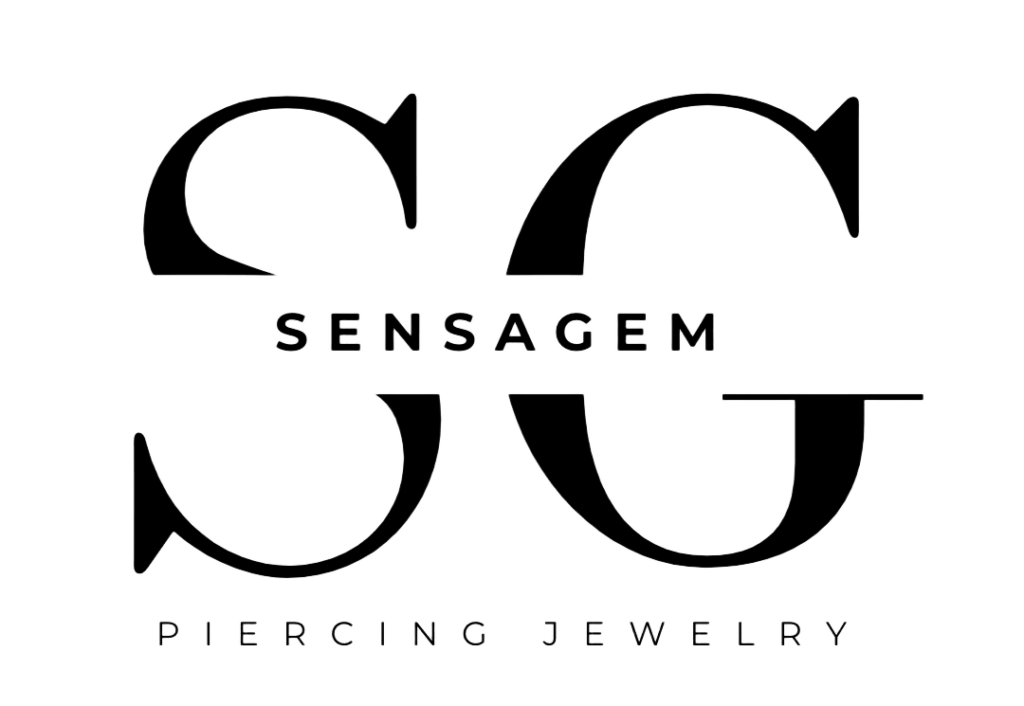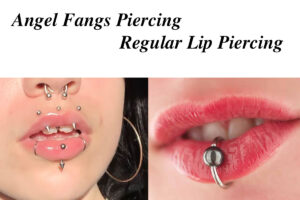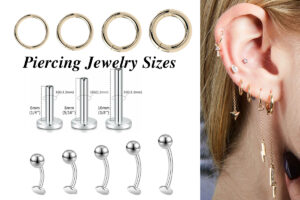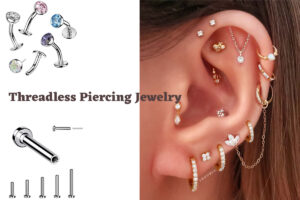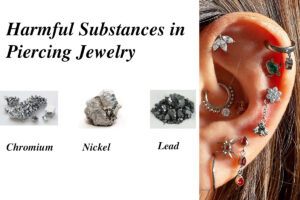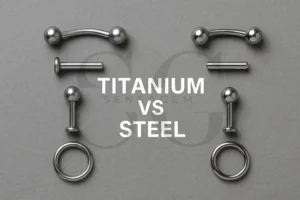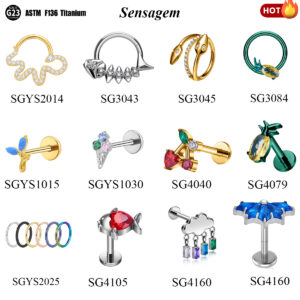Introdução: Why Knowing Jewelry Types Matters
Whether you’re a seasoned piercer, a studio buyer, or running your own online store, understanding piercing jewelry is more than just recognizing pretty pieces. It’s about structure, segurança, healing compatibility—and of course—what your customers are asking for.
Isso sente, we talk to importers, wholesalers, and professional piercers across the globe. One thing we hear consistently: the better you understand the product, the easier it is to choose (and sell) the right one.
This guide is here to help you make those decisions with confidence. We’ll walk through all the major types of piercing jewelry—how they’re built, where they’re worn, what materials work best—so you can stock your shelves (and your trays) with jewelry that actually fits your customers’ needs.
1. Jewelry by Structure: How It’s Built Affects How It’s Worn
The internal engineering of a piece of jewelry might not be visible to the untrained eye, but it directly affects how easy it is to insert, how comfortable it feels, and how well it heals.
Here are the five most common piercing jewelry structures you’ll come across—and when to use each one:
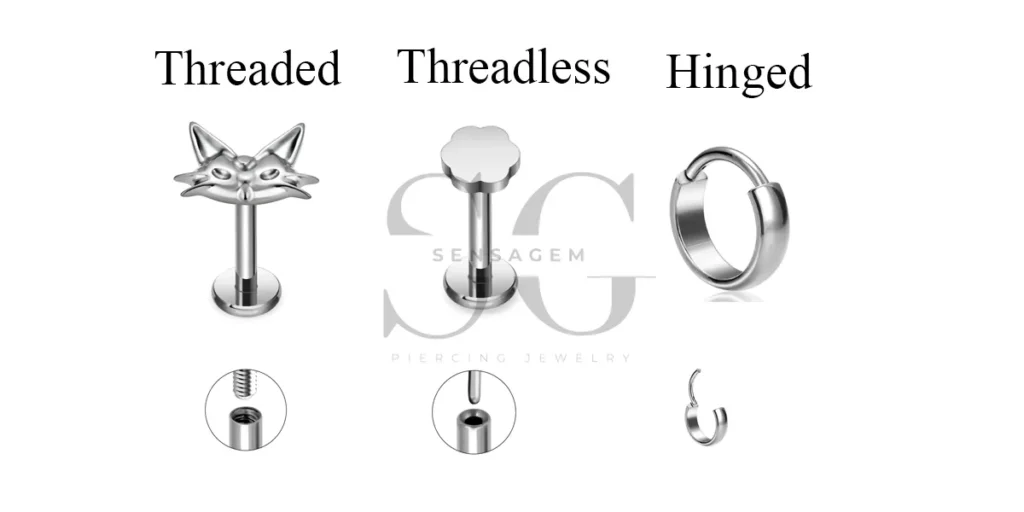
🔩 External Threaded Jewelry
This is the oldest and most traditional type. You’ll recognize it when the threads (the screw part) are visible on the post. The decorative end or ball screws onto the externally threaded post.
Pros:
Mais acessível
Widely available
Cons:
Threads can irritate the piercing tunnel during insertion
Not ideal for fresh piercings
Best for:
Healed piercings where cost is a priority. Think budget-friendly nostril studs, lobe barbells, etc.
🧲 Internal Threaded Jewelry
A safer upgrade from external threading. Aqui, o threads are hidden inside the post, and the decorative top has a small screw that fits inside.
Pros:
Smooth post: easier to insert without trauma
Stronger hold for threaded ends
Recommended by APP (Association of Professional Piercers)
Cons:
Slightly higher cost due to more precision in production
Best for:
Fresh piercings, high-end studios, customers with sensitive skin. Most professional-grade labrets and barbells are internal threaded.
👉 Related Reading: Compreendendo diferentes tipos de estruturas de jóias de perfuração
🧷 Threadless Jewelry (Push-Fit Design)
Threadless jewelry is one of the most loved innovations in modern piercing. It uses tension-fit mechanics—the post has no screw, and the top pin is slightly bent to hold itself in place.
Pros:
Quick and tool-free insertion
Ultra smooth surface = zero irritation
Easy to swap tops while keeping the post in
Cons:
Slight learning curve to bend the pin correctly
Not always compatible across brands
Best for:
Studios that want ease and elegance. Great for healed lip, narina, TRAGUS, or helix piercings.
👉 Related Reading: Como escolher o tamanho certo para suas jóias de piercing Labret
👉 Related Reading: O que são joias piercing sem fio? Por que é popular em joias piercing modernas
🔒 Hinged Segment Rings & Clickers
Clickers and hinge rings are structured like hoops with built-in clasps. You open them like a door hinge and snap them closed.
Pros:
Seamless, clean appearance
No lost parts—everything is attached
Comfortable and secure
Cons:
Hinges can wear out over time with repeated opening
May not work for thicker gauges or complex placements
Best for:
Septum, jornada, helix, and navel jewelry. A must-have for fashion-forward customers.
👉 Related Reading: Anel de nariz de barra circular: Escolhendo, Vestindo, e manutenção
🔘 Captive Bead Rings (Cbrs) & Seamless Hoops
These are the classic hoop styles, where a small bead “snaps” into place using tension or pressure.
Pros:
Timeless look
Beads can be decorative (gemstone, opal, etc.)
Cons:
May be tricky to open/close without tools
Tension can loosen over time
Best for:
Lobe, eyebrow, cartilagem, and intimate piercings. Good choice for DIY-friendly customers.
2. Jewelry by Shape & Function: Matching the Right Piece to the Right Piercing
After understanding the structure, the next most important element is the forma—how the jewelry fits on or inside the body, how it moves, and how it looks. Certain shapes are designed for specific piercings, and choosing the wrong one can cause irritation, migration, or prolonged healing.
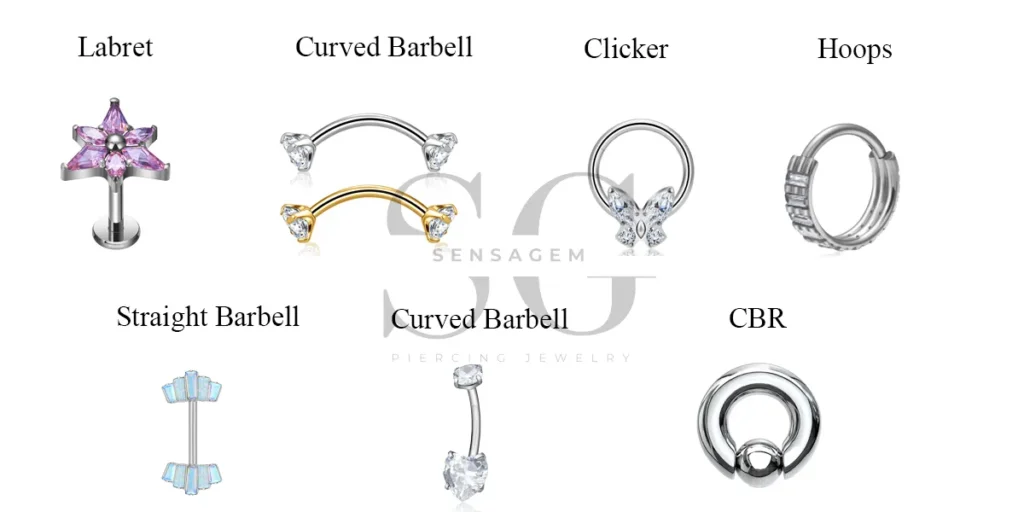
📎 Labrets
Structure: Flat disc on one end, decorative top (threaded or threadless) on the other.
Common Gauges: 16G, 18G
Common Lengths: 6mm – 10mm
Best for:
Lip piercings (Labret, Monroe, medusa)
Cartilage piercings (TRAGUS, helix)
Nostril piercings (when a flat back is preferred)
Pros:
Flat disc is comfortable inside the mouth or behind the ear
Minimal movement = better healing
Often threadless for quick swapping
Cons:
Can sink into swollen piercings if too short
Flat disc may trap skin debris if not cleaned
👉 Tip: Titanium threadless labrets are top choices for professional studios for initial lip piercings.
🔄 Circular Barbells
Structure: Horseshoe shape with threaded balls or spikes on both ends.
Common Gauges: 14G, 16G
Common Diameters: 8mm – 14mm
Best for:
Septum piercings
Daith and rook
Eyebrow and nipple piercings
Genital piercings (Prince Albert, etc.)
Pros:
Easy to insert and remove
Decorative ends allow customization
Suitable for thicker piercings and stretching
Cons:
Can rotate inside the piercing
Threaded ends may loosen if not properly tightened
👉 See also: Anel de nariz de barra circular: Escolhendo & Wearing Tips
🪝 Curved Barbells
Structure: Gently curved bar with threaded ends, typically ball-shaped.
Common Gauges: 16G, 14G
Common Lengths: 6mm – 12mm
Best for:
Eyebrow piercings
Navel (umbigo) piercings
Vertical labret
Bridge piercings
Pros:
Matches natural curves of certain body areas
Reduces pressure on tissue during movement
Stylish and versatile for multiple placements
Cons:
Not always suitable for high-movement areas
Improper sizing may cause migration
📌 Product Feature: SG6017 G23 Titanium Threaded Belly Button Ring – a classic curved barbell with anodized rainbow finish.
🧿 Captive Bead Rings (Cbrs)
Structure: Seamless circular hoop with tension-held bead in the middle.
Common Gauges: 16G, 18G
Common Diameters: 8mm – 12mm
Best for:
Nose piercings
Ear cartilage (helix, rook)
Lip and eyebrow
Pros:
Classic look with bead accent
Secure once inserted
Available in many colors/materials
Cons:
Difficult to insert without ring opener pliers
Tension can loosen over time
🔗 Segment Rings & Clickers
Structure: Ring with hinged or removable segment that clicks into place
Common Gauges: 16G, 14G
Common Diameters: 6mm – 12mm
Best for:
Septum, jornada
Lobe and helix
Cartilage piercings
Nipple (clickers with charms)
Pros:
Seamless design
Easy to open/close without tools
Secure hold, ideal for sensitive areas
Cons:
Hinges may wear out over time
More expensive due to intricate mechanism
👉 Related: Threadless Design: Por que é popular
3. Jewelry by Piercing Location: What to Use & Avoid for Each Body Area
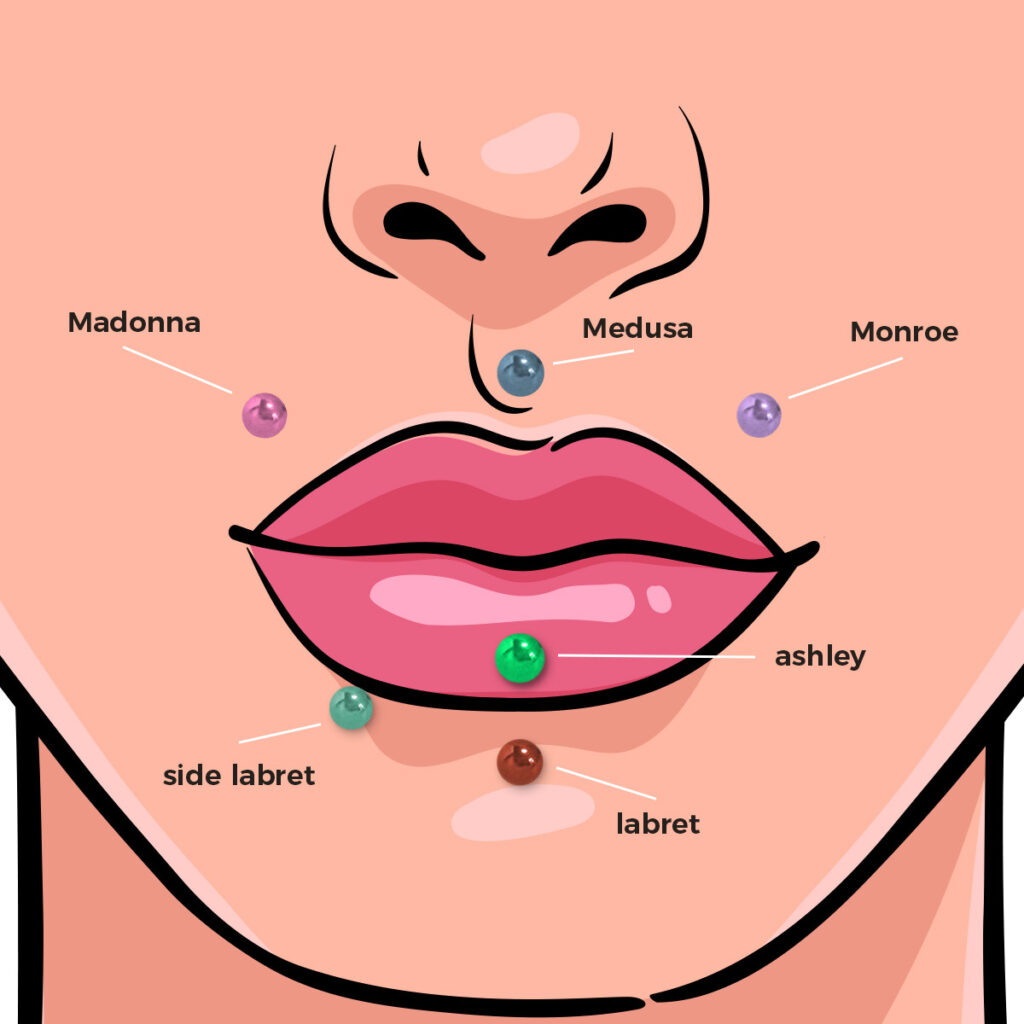
Choosing the right jewelry isn’t just about the design—it also depends on where it will be worn. Different piercing locations have different anatomical requirements. Wearing the wrong jewelry can cause irritation, poor healing, ou até rejeição penetrante. Let’s break down the best jewelry styles for each body part and why they matter.
🔗 Related Reading: Compreendendo diferentes tipos de estruturas de jóias de perfuração
👂 Ear Piercings
Popular Types: Earlobe, Hélice, TRAGUS, Concha, Industrial, Daith
Best Jewelry:
Earlobe: Labrets, studs, Clickers, or small hoops
Helix/Tragus: Flat-back labrets or micro barbells
Industrial: Straight barbell (usually 14G, with precise length based on anatomy)
Tips:
For fresh piercings, implant-grade titanium or 316L surgical steel is safest.
Industrial piercings require exact measurements—barbells too short or too long can cause migration.
👃 Nose Piercings
Popular Types: Nostril, High Nostril, Septum
Best Jewelry:
Nostril: L-shaped studs, parafusos, tiny CBRs, and threadless push-fit designs
Septum: Circular barbells, seamless rings, or hinged clickers
Tips:
Septum jewelry should be properly aligned to sit comfortably inside the nose.
Titanium is ideal for nose piercings due to lower risk of irritation.
👄 Lip & Piercings orais
Popular Types: Labret, Monroe, Medusa, Snake Bites
Best Jewelry:
Threadless titanium labrets with flat disc backs
Biocompatible acrylic ends for added comfort inside the mouth
Tips:
Jewelry should sit flush inside the mouth to avoid enamel damage
Choose shorter bars post-healing to minimize movement and swelling
🧠 Bonus: Curious about how threadless jewelry works? Read Threadless Design: Por que é popular
💪 Body Piercings
Popular Types: Navel, Nipple, Superfície
Best Jewelry:
Navel: Curved barbells (typically 14G, 10milímetros) with externally or internally threaded balls
Nipple: Straight barbell or circular barbell
Surface Piercings: Surface barbells or titanium anchors
Tips:
Avoid CBRs in healing belly or nipple piercings; they tend to rotate and disrupt healing
For surface piercings, use flexible or internally threaded jewelry to prevent rejection
🌐 Want to learn more about barbells and curved designs? Check out Halteres Curvos: Tamanhos, Usos & Materiais
🔒 Intimate Piercings
🔒 Intimate Piercings
Popular Types: Vertical Hood (VCH), Prince Albert, Christina, Frenum
Best Jewelry:
Smooth, internally threaded titanium barbells or circular barbells
Jewelry must be custom-sized and polished to avoid irritation
Tips:
Always use certified, hypoallergenic materials like ASTM F136 titanium
Avoid harsh angles, rough threads, or cheap metal alloys—comfort and hygiene are critical
4. Choosing the Right Material: Titânio, Steel & Beyond
When it comes to piercing jewelry, material matters as much as style. A stunning design means nothing if it causes irritation or delays healing. Whether you’re a studio owner, atacadista, or just passionate about safe body modification, understanding the pros and cons of common materials will help you choose wisely.

🧪 Titanium (ASTM F136 / G23)
Why it’s popular: Titanium is considered the gold standard for initial piercings. It’s lightweight, strong, non-corrosive, and completely nickel-free.
Key benefits:
✅ Hypoallergenic (Perfeito para a pele sensível)
✅ Certified safe for implantation (ASTM F136 standard)
✅ Anodizable into brilliant colors (learn more in Anodizing for Piercing Jewelry – Titanium vs. Aço inoxidável)
✅ Corrosion-resistant and lightweight
Best for: Initial piercings, sensitive clients, premium jewelry collections
🔗 More: Titanium Piercing Jewelry: Grades, Benefits & Use Cases
🔩 Surgical Stainless Steel (316eu / 316LVM)
Why it’s a favorite: Durable and affordable, surgical steel is widely used for both fresh and healed piercings. No entanto, it does contain trace nickel.
Key benefits:
✅ Strong, acessível, and long-lasting
✅ Excellent corrosion resistance
✅ Mirror-polished surface ideal for body contact
Caution: 316 steel may cause irritation for clients with nickel sensitivity. In these cases, 316eu (low carbon) or 316LVM (vacuum-melted) options are preferred.
Best for: Healed piercings, bulk orders, and everyday wear
📖 Learn the difference: 316L vs 316 Surgical Steel – What’s Best for Piercing Jewelry?
🧼 Bioplast, Acrylic & PTFE
Why it’s trending: Non-metallic materials like Bioplast and PTFE are ideal for piercings that require flexibility—like pregnancy navel jewelry or during MRIs.
Key benefits:
✅ Flexible and comfortable
✅ Available in vibrant colors
✅ Suitable for temporary wear or healing transition periods
Caution: Not as durable as metals; may degrade over time. Use only from reputable sources.
Best for: Pregnancy-safe piercings, medical procedures, lightweight facial jewelry
Material | Hipoalergênico | Suitable for Fresh Piercings | Custo | Corrosion Resistance | Opções de cores |
|---|---|---|---|---|---|
Titânio | ✅ Excellent | ✅ Yes | 💲💲💲 | ✅ Excellent | 🌈 Yes (anodized) |
316L Steel | ⚠️ Moderate | ⚠️ With Caution | 💲💲 | ✅ Very Good | ❌ No |
Ouro (14K+) | ✅ Good | ✅ Yes | 💲💲💲💲 | ✅ Excellent | 🌟 Yes |
Bioplast/PTFE | ✅ Yes | ✅ Yes (temp use) | 💲 | ⚠️ Moderate | 🌈 Yes |
Niobium | ✅ Excellent | ✅ Yes | 💲💲💲 | ✅ Excellent | 🌈 Yes |
5. Threading Types and Jewelry Mechanics
When choosing body jewelry, most people focus on the visible style or material—but how a piece opens, closes, ou attaches is equally important. For both professionals and wearers, understanding threading systems helps ensure safety, ease of use, and comfort.
🔩 Threaded Jewelry
Threaded jewelry consists of two parts: a shaft (bar) and a threaded end that screws in.
Rosqueado internamente
Threads are hidden inside the shaft, creating a smooth post that slides gently through piercings.
✅ Best for fresh piercings
✅ Minimizes skin trauma
🔗 Related: Understanding Different Piercing Jewelry Structures
Rosqueado externamente
Threads are on the outside of the bar. This can cause discomfort when inserted into a fresh piercing.
❌ Not recommended for new piercings
✅ Cost-effective for healed piercings
Common types: Halteres, labretes, Barbells curvos, industrial bars
💡 Pro Tip: Choose internally threaded styles for professional studios to reduce healing complications.
🧲 Threadless Jewelry (Push-fit)
Threadless systems use pressure and tension to hold ends in place—no screwing required. A pin on the decorative end is slightly bent and pushed into a hollow shaft.
Benefits:
✅ Easy to insert and remove
✅ Smooth surface, ideal for healing piercings
✅ Secure hold (when properly fitted)
✅ Widely used in labretes, nose studs, and cartilage jewelry
Best for: Clients who change tops frequently, pele sensível, healed or healing piercings
🔗 Learn more: Threadless Design – Why It’s Popular in Modern Piercing Jewelry
🔒 Hinged and Clicker Jewelry
These styles use a built-in hinge or clasp for secure closure—perfect for rings and segment jewelry.
Rings de cliques: Feature a hinged segment that clicks into place.
✅ Popular in septo, jornada, helix, e piercings do nariz
✅ Easy one-hand operation
✅ Stylish and secure
🔗 Also see: Anel de nariz de barra circular: Escolhendo & Wearing Tips
Hinged Segment Rings: The ring opens on a hinge and clicks shut seamlessly.
✅ Smooth and snag-free
✅ Great for high-movement piercings
Mechanism | Ideal para | Healing-Friendly | Secure Hold | Easy to Change | Custo |
|---|---|---|---|---|---|
Rosqueado internamente | Fresh piercings | ✅ Yes | ✅ Strong | ⚠️ Moderate | 💲💲 |
Rosqueado externamente | Healed piercings | ❌ No | ✅ Strong | ⚠️ Moderate | 💲 |
Sem fio | Healed & cura | ✅ Yes | ✅ Strong | ✅ Very easy | 💲💲💲 |
Hinged/Clicker | Septum, helix, jornada | ✅ Yes | ✅ Secure | ✅ Easy | 💲💲💲 |
6. Jewelry Sizing: Medidor, Comprimento, and Diameter
Escolhendo o direito tamanho is as important as selecting the right material or design. The wrong gauge or length can lead to discomfort, migration, or even rejection of the piercing. Whether you’re a wholesaler, studio owner, or new enthusiast, understanding sizing standards is essential.
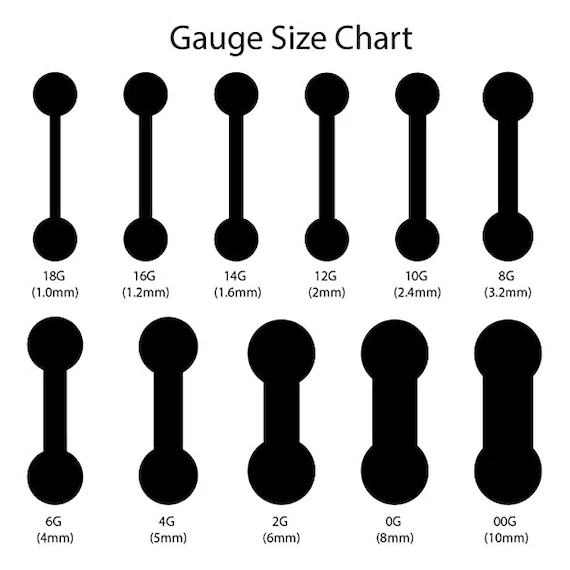
📏 Gauge (Thickness)
Medidor refers to the thickness of the jewelry bar or post. It’s usually measured in American Wire Gauge (AWG)—the lower the number, o thicker the jewelry.
Medidor | Millimeter (milímetros) | Common Use |
|---|---|---|
20G | ~0.8 mm | Nostril, ear lobes |
18G | ~1.0 mm | Nariz, helix |
16G | ~1.2 mm | Cartilagem, lip, TRAGUS |
14G | ~1.6 mm | Navel, industrial, mamilo |
12G | ~2.0 mm | Stretching piercings |
💡 Para dica: Always follow the piercer’s recommendation or default studio sizing, especially for healing piercings.
📐 Length
Comprimento is the wearable area of a barbell or labret post—measured between the two ends.
Piercing Area | Common Length |
|---|---|
Earlobe | 6mm – 8mm |
TRAGUS | 6milímetros |
Lip / Labret | 8mm – 10mm |
Navel | 10mm – 12mm |
Sobrancelha | 8milímetros |
Industrial | 35mm – 38mm |
🔗 Related: Choosing the Perfect Labret Jewelry Size
🌀 Diameter (For Rings)
Diâmetro is the distance across the inside of a ring, measured in millimeters.
Piercing Type | Typical Diameter |
|---|---|
Septum | 8mm – 10mm |
Nose Ring | 6mm – 10mm |
Daith | 8milímetros |
Nipple Ring | 12mm – 16mm |
Cartilage Hoop | 6mm – 8mm |
Why Size Matters
✅ Too short: Causes pressure, inchaço, or embedding
✅ Too long: Leads to movement, irritação, or snagging
✅ Right size: Promotes healing, conforto, and long-term wear
Many studios recommend initial piercings be done with slightly longer posts to accommodate swelling—then resized after healing.
7. Materials Used in Piercing Jewelry: Pros, Cons & Use Cases
When it comes to safety, durabilidade, e estética, material is a key factor in piercing jewelry. The wrong material can lead to allergic reactions, delayed healing, or corrosion—while the right one can ensure both style and comfort for years.
🔩 Titanium (e.g., ASTM F136 / G23)
Pros:
Hypoallergenic and nickel-free
Lightweight but strong
Corrosion-resistant
Ideal for anodizing (rainbow colors)
Best for:
Fresh piercings, pele sensível, professional studios
👉 Related: Guia final para titânio por atacado & Stainless Steel Jewelry
👉 Also see: ASTM F136 Titanium vs. 316L Aço inoxidável: Melhores materiais para piercing jóias
🔧 Stainless Steel (316eu / ASTM F138)
Pros:
Affordable and durable
Highly corrosion-resistant
Polished finish, estética moderna
Cons:
Contains trace nickel (not ideal for everyone)
Slightly heavier than titanium
Best for:
Healed piercings, industrial style jewelry, large volume B2B purchases
👉 Related: 316 & 316L Piercing Jewelry – Why Surgical Steel Is the Best Choice
🧪 Bioplast / PTFE
Pros:
Flexible and comfortable
Hipoalergênico
Autoclavable (suitable for sterilization)
Cons:
Less durable
Not suitable for every aesthetic
Best for:
Pregnancy belly rings, initial lip/labret piercings, medical use
Material Safety Tip
Always ensure materials are certificado (e.g., ASTM F136 for titanium or ASTM F138 for steel) and sourced from reputable manufacturers. Avoid generic “surgical steel” or mystery metals with no traceability.
🔗 Related: Piercing Jewelry Certification – Understanding Stainless Steel & Materiais de titânio
8. Jewelry Backing and Closures: Functional and Style Considerations
The type of closure mechanism used in piercing jewelry is not just a matter of convenience—it affects comfort, higiene, segurança, e estética. Different closures serve different purposes based on the location of the piercing, personal preference, and lifestyle needs.
🔒 Common Closure Types:
1. Rosqueado (Internal & External)
Internal thread: the post is smooth, and the threading is inside; ideal for initial piercings (less tissue trauma)
External thread: the threading is on the outside of the post; more affordable but less ideal for fresh piercings
✅ Recommended for: Labret, Barbells, tongue rings, industrial barbells
🔗 Related: Threadless Design: Por que é popular
2. Sem fio (Push-Fit / Press-Fit)
Uses tension instead of screw threads
Cleaner look, easier insertion/removal
Especially popular in modern studios and higher-end jewelry
✅ Recommended for: Hélice, narina, TRAGUS, labret jewelry
👉 Also see: Choosing the Perfect Labret Jewelry Size
3. Clicker
Hinged segment ring that clicks into place
Easy to open and close, secure fit
Great for seamless look in nose, septo, or daith piercings
✅ Recommended for: Septum, jornada, helix, piercings de cartilagem
🔗 Related: Anel de nariz de barra circular: Escolhendo & Wearing Tips
4. Captive Bead Ring (CBR)
Classic style where a single bead is held by tension
Offers 360° rotation, minimal design
Slightly trickier to insert/remove
✅ Recommended for: Ears, narina, mamilo, eyebrow
5. Fixed Ball or No-Closure (Seamless)
Offers a minimal look
Some seamless rings require bending to open/close
Not ideal for constant changing
✅ Recommended for: Nostril, helix, conch
How to Choose the Right Closure:
Consideration | Best Option |
|---|---|
First-time piercings | Threadless or internal thread |
Everyday wear | Clicker or threadless |
Minimalist look | Seamless or fixed bead |
Secure hold for active users | Threaded or clicker |
Choosing the right closure isn’t just about looks—conforto, segurança, and ease of cleaning are just as important. Se você não tem certeza, threadless or clicker-style jewelry offers the best of both worlds.
9. How to Match Jewelry Type to Piercing Location
Not all jewelry types are suitable for every piercing. Escolhendo o direito structure, forma, and material for a specific location can influence healing time, conforto, and long-term wearability. Here’s a location-by-location guide to help you or your customers make informed decisions.
👂 Ear Piercings
Lobe:
Best for: Studs, labretes, captive bead rings
Notas: Heals quickly; versatile for many styles
Hélice / Cartilagem:
Best for: Halteres, Clickers, studs
Notas: Thinner skin, longer healing time—smooth edges are a must
TRAGUS / Daith / Rook:
Best for: Circular barbells, Clickers, Barbells curvos
Notas: Opt for smaller gauges and comfortable closures
👃 Nose Piercings
Nostril:
Best for: Nose studs, hoops, L-shaped pins
Notas: Choose flat backs or screw-on studs to prevent irritation
🔗 Related: Choosing the Perfect Labret Jewelry Size
Septum:
Best for: Circular barbells, Clickers, seamless rings
Notas: Avoid sharp edges or heavy pieces during healing
👄 Lip & Piercings orais
Labret / Monroe / Medusa:
Best for: Flat-back labrets, threadless posts
Notas: Look for jewelry with smooth backs to protect gums and teeth
🔗 Related: Threadless Design: Por que é popular
Tongue:
Best for: Halteres (titanium preferred)
Notas: Use internally threaded jewelry to reduce tissue damage
💉 Eyebrow Piercings
Best for: Curved barbells or surface bars
Notas: Avoid large gauge jewelry; go for lighter-weight options for comfort
✨ Body Piercings
Navel (Belly Button):
Best for: Curved barbells, dangle navel rings
Notas: Avoid overly heavy dangles for fresh piercings
Nipple:
Best for: Halteres, Clickers, escudos
Notas: Opt for materials with excellent biocompatibility like 316L or F136 titanium
🔗 Related: Guia de segurança para os melhores materiais de jóias de piercing
10. Material Selection for Each Jewelry Type
Escolhendo o direito material is just as important as selecting the jewelry style. The wrong material can cause irritation, delay healing, or even lead to allergic reactions—especially in fresh piercings. Below is a quick overview of common materials and their best uses:
🛡 Titanium (ASTM F136 / F1295)
Best For: All piercings, especially fresh ones
Why Choose It:
Hypoallergenic and biocompatible
Lightweight and corrosion-resistant
Ideal for anodizing (vibrant color options)
🔗 Related: F136 Titanium vs.. 316L Stainless Steel – Best for Piercing Jewelry
🧲 316L Surgical Stainless Steel
Best For: Healed piercings, budget-conscious options
Why Choose It:
Affordable and widely available
Durable with decent corrosion resistance
May contain trace nickel (not ideal for ultra-sensitive skin)
🔗 Related: 316 & 316L Piercing Jewelry – Why Surgical Steel Is the Best Choice
🌿 Bioflex & PTFE (Flexible Plastics)
Best For: Oral piercings, pregnancy, medical procedures
Why Choose It:
Flexible and lightweight
Metal-free (safe for imaging, surgeries)
Ideal for retainers and temporary replacements
Pro Tips for Material Selection
New Piercings? Stick with titanium or 316L steel
Sensitive skin? Go nickel-free—Titanium is your best friend
Style-focused buyers? Offer a gold or anodized titanium option
Studios/retailers? Always verify certifications (e.g., ASTM F136, Mill Certification)
11. Threading Types: Rosqueado, Sem fio & Clicker Explained
When it comes to the mechanism that holds your jewelry together, the threading style plays a big role in both comfort and practicality. Here’s how each type works and when to use them:
🔩 Threaded Jewelry
Description: The decorative end (top) is screwed onto the post/bar.
External Thread: Threads are on the outside of the post. Less ideal for healing piercings as it can scrape tissue.
Tópico interno: Threads are inside the post—safer and smoother during insertion.
✅ Best For: Experienced users and secure applications like barbells or industrials.
✨ Threadless Jewelry (Push-fit)
Description: A flexible pin on the decorative end is pushed into a hollow post, held by tension.
Easier and faster to insert
No threading = less trauma during changes
Popular with studios for nose, orelha, and labret piercings
🔗 Related: Threadless Jewelry: Why It’s Popular in Modern Piercings
🔁 Clicker Jewelry
Description: Features a hinge and clasp that “clicks” shut.
Seamless look
No tools required
Common in septum, jornada, helix, e piercings da cartilagem
Quick Comparison
Tipo | Secure? | Easy to Change? | Best For |
|---|---|---|---|
Rosqueado | ✅ High | ❌ Moderate | Halteres, industrials |
Sem fio | ✅ High | ✅ Very Easy | Nariz, lips, ear studs |
Clicker | ✅ High | ✅ Very Easy | Septum, jornada, helix, anéis |
12. Piercing Jewelry Sizes: Gauges, Lengths & Diameters
Choosing the right size is just as important as picking the right material or style—especially when it comes to comfort, cura, e estética.
📏 What is a Gauge?
O medidor (G) measures the thickness of the jewelry post or bar.
Lower number = thicker jewelry (e.g., 14G is thicker than 18G)
Médicos comuns:
20G–18G: nose rings, ear studs
16G–14G: cartilagem, septo, lip, and eyebrow
12G and above: stretched piercings, industrials
👉 Related: Choosing the Perfect Labret Jewelry Size
📐 Length and Diameter
Comprimento refers to how long the wearable part is (e.g., post or barbell)
Diâmetro applies to circular jewelry like hoops, Cbrs, and clickers
Example Reference Table:
Piercing Type | Recommended Gauge | Recommended Length/Diameter |
|---|---|---|
Nostril | 18G–20G | 6mm–8mm (post) / 8mm–10mm (ring) |
Labret/Lip | 14G–16G | 6mm–10mm |
Sobrancelha | 16G | 8mm–10mm |
Navel | 14G | 10milímetros |
Helix/Cartilage | 16G | 6mm–8mm |
Septum | 14G–16G | 8mm–10mm |
⚠️ Size Matters for Healing
Too tight = pressure, inchaço, irritação
Too loose = snagging, migration risk
💡 Always consult a professional piercer when unsure of proper sizing.
13. Materials for Piercing Jewelry: Beyond Titanium & Aço inoxidável
While Titânio de grau de implante e 316L Aço inoxidável remain the gold standard in piercing jewelry, other materials are also used in specific contexts. Let’s take a closer look:
🛠️ Popular Materials in the Market
Material | Principais recursos | Best Use Cases |
|---|---|---|
Titânio (ASTM F136) | Hipoalergênico, leve, resistente à corrosão | Initial piercings, pele sensível, anodizing |
316L Aço inoxidável | Durável, polished, acessível | Healed piercings, aesthetic variety |
Niobium | Hipoalergênico, similar to titanium, good for anodizing | Initial piercings, color customization |
Ouro (14K+) | Biocompatible if nickel-free, elegant | Healed piercings, luxury body jewelry |
Bioplast/PTFE | Flexible, nickel-free, autoclavable | Pregnancy piercings, medical/sports use |
Glass (Borosilicate) | Smooth, inert, non-metallic | Ear plugs, túneis, septum retainers |
Wood, Horn, Pedra | Organic, breathable, handcrafted | Stretched lobes (only after full healing) |
❗ Materials to Avoid
Mystery metals or non-certified “surgical steel”
Acrylics for fresh piercings (non-autoclavable, porous)
Plated or coated metals (can chip or cause reactions)
👉 Related: Guia de segurança para os melhores materiais de jóias de piercing
14. Jewelry Trends & Style Tips for Studios and Retailers
Staying on top of piercing jewelry trends isn’t just for fashion lovers—it’s crucial for varejistas, studio owners, and distributors who want to stay competitive in a fast-moving market. Here are some top trends and practical tips that are shaping customer preferences in 2025.
🔮 Emerging Trends in Piercing Jewelry
1. Minimalist & Micro Designs
Ultra-small labrets, studs, and hoops are trending.
Popular for second and third ear lobe piercings, narina, and helix.
Matte and brushed finishes in titanium are gaining traction.
2. Color Customization
Anodized titanium in azul, arco-íris, roxo, and gold finishes is seeing a surge.
Studios offer color options per piercing area (e.g., gold for nostrils, rainbow for cartilage).
👉 Related: Understanding Anodizing Process – Titanium vs Stainless Steel
3. Threadless Jewelry Systems
Growing in popularity due to ease of use and secure fit.
Especially favored by professional piercers for initial jewelry.
4. Ethically Made & Certified Jewelry
Gen Z and Millennial buyers are more conscious of sourcing.
Jewelry with REACH, ASTM, or APP certifications is increasingly demanded.
5. Stacking & Mixing Styles
Customers mix Barbells, hoops, e Clickers across the same ear or facial region.
Studios benefit from offering sets or curated bundles.
Style Tips for Retailers & Studios
Tip | Benefit |
|---|---|
Offer multiple sizes & thicknesses per model | Helps fit unique anatomy, reduces return rate |
Provide anodizing color charts in-store or online | Empowers customers to personalize selections |
Educate staff on material certifications | Builds trust and boosts upsells |
Keep top 5 styles in-stock at all times | Reduces wait time, increases walk-in conversions |
Display curated collections by piercing area | Enhances customer experience and decision-making |
15. Final Tips for Choosing the Right Jewelry for Your Business & Clients
Whether you’re a piercing studio, online retailer, or wholesaler, offering the right types of jewelry is key to success. Here’s a quick checklist to help you align your product offerings with what clients are looking for:
✅ Material Matters
Always stock Titânio de grau de implante (ASTM F136) e 316L aço cirúrgico as your base metals. These are biocompatible, certificado, and trusted by professional piercers.
👉 Learn more: Guia final para titânio por atacado & Stainless Steel Jewelry
✅ Focus on Fit & Function
Offer a range of post lengths e medidores to fit different anatomies.
Prioritize threadless or internally threaded designs for initial piercings.
Consider ergonomics: curved barbells for navels, straight for industrials, hinged rings for septums, etc.
✅ Listen to Studio Trends
Regularly ask your B2B clients:
What styles are popular right now?
Are customers asking for specific finishes (Matte, anodized, polished)?
Do they need small batches of custom-engraved or color-coded jewelry?
✅ Curate for Piercing Areas
Instead of offering only by SKU, create sections like:
“Jewelry for Nostril Piercings”
“Best Clickers for Septum & Daith”
“Top Labrets for Helix & Lip”
✅ Build Trust with Documentation
Clearly label all materials and manufacturing specs.
Offer certificates of origin or mill test reports for titanium and surgical steel.
Provide easy-cleaning and aftercare tips with purchase.
📦 Bonus Tip: Starter Kits for Studios
Bundle jewelry by type or piercing area (e.g., “Starter Set for Ear Projects”) to help new studios or resellers test different styles with minimal risk.
If you’re looking to stock high-quality wholesale piercing jewelry made from certified titanium and stainless steel, Sensagem is here to help.
Contate-nos for custom quotes, catalogs, or sample kits tailored to your market.
Would you like me to compile all sections into a formatted export-ready article, or start working on the first cluster article in this second content cluster?
